Global HRM Strategies and Singapore Airlines Case Study
VerifiedAdded on 2022/09/08
|17
|5316
|15
Report
AI Summary
This report provides a comprehensive analysis of the global HRM strategies employed by Singapore Airlines. It begins with an introduction highlighting the challenges and importance of effective HRM in the airline industry, followed by an analysis of the external environment using the PESTLE framework, examining political, economic, social, technological, legal, and environmental factors impacting the airline. The report then delves into the national culture analysis using Hofstede's cultural dimensions to understand the cultural nuances relevant to SIA's operations. Key HRM strategies are explored, including recruitment and selection processes, training and development programs, employee participation and engagement initiatives, and performance management systems. Recommendations for improvement are provided, and the report concludes with a summary of findings and references.
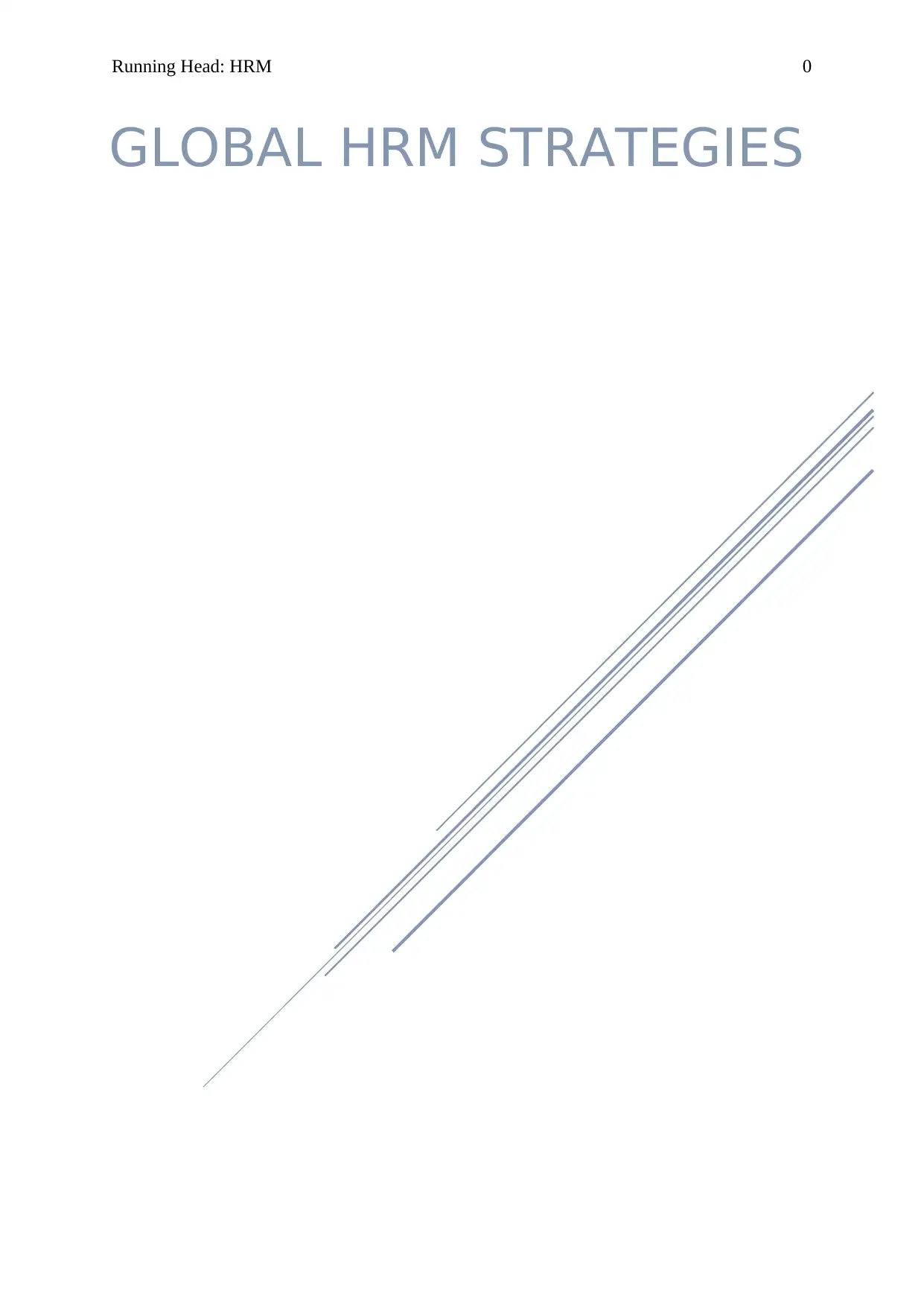
Running Head: HRM 0
GLOBAL HRM STRATEGIES
GLOBAL HRM STRATEGIES
Paraphrase This Document
Need a fresh take? Get an instant paraphrase of this document with our AI Paraphraser
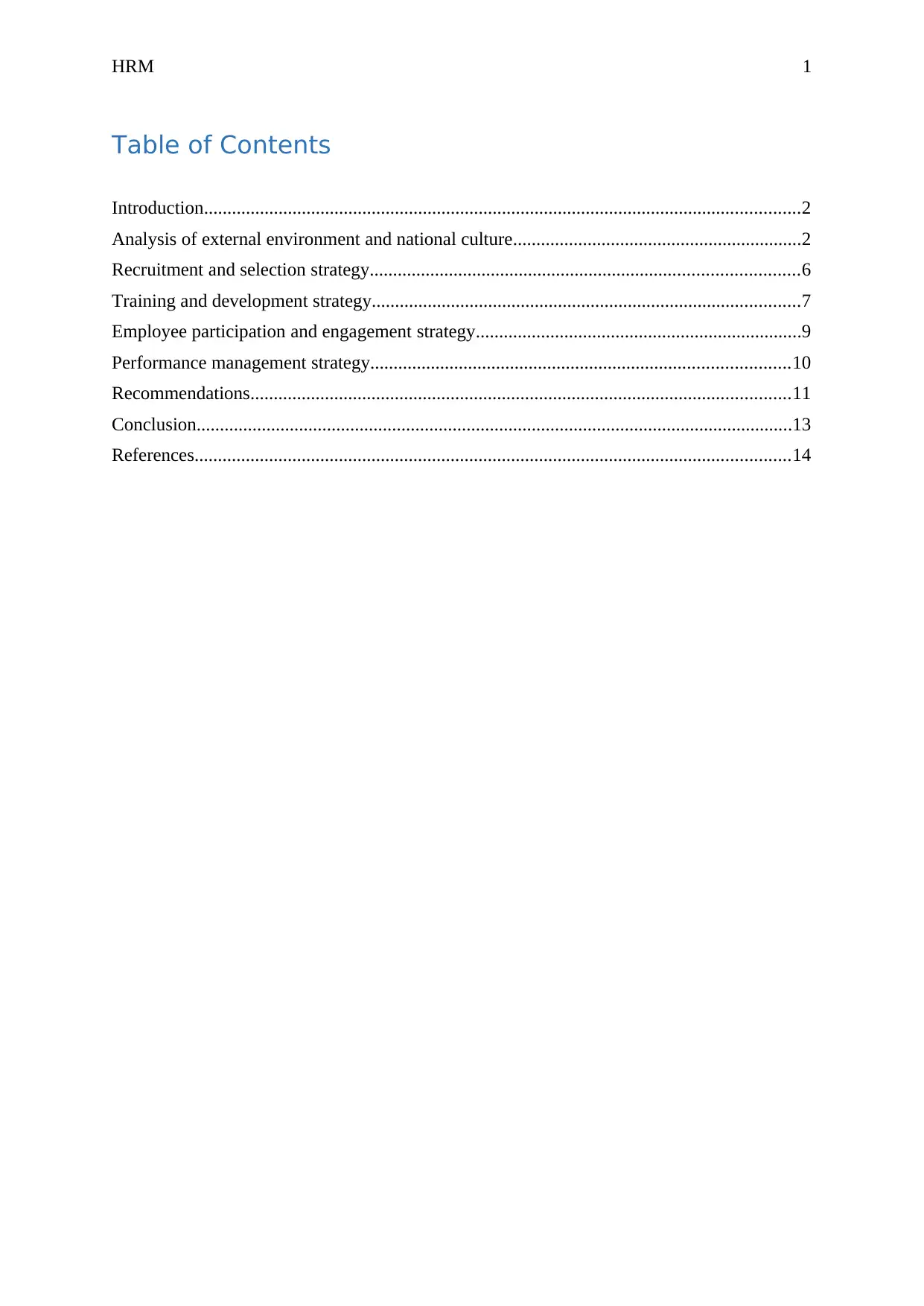
HRM 1
Table of Contents
Introduction................................................................................................................................2
Analysis of external environment and national culture..............................................................2
Recruitment and selection strategy............................................................................................6
Training and development strategy............................................................................................7
Employee participation and engagement strategy......................................................................9
Performance management strategy..........................................................................................10
Recommendations....................................................................................................................11
Conclusion................................................................................................................................13
References................................................................................................................................14
Table of Contents
Introduction................................................................................................................................2
Analysis of external environment and national culture..............................................................2
Recruitment and selection strategy............................................................................................6
Training and development strategy............................................................................................7
Employee participation and engagement strategy......................................................................9
Performance management strategy..........................................................................................10
Recommendations....................................................................................................................11
Conclusion................................................................................................................................13
References................................................................................................................................14
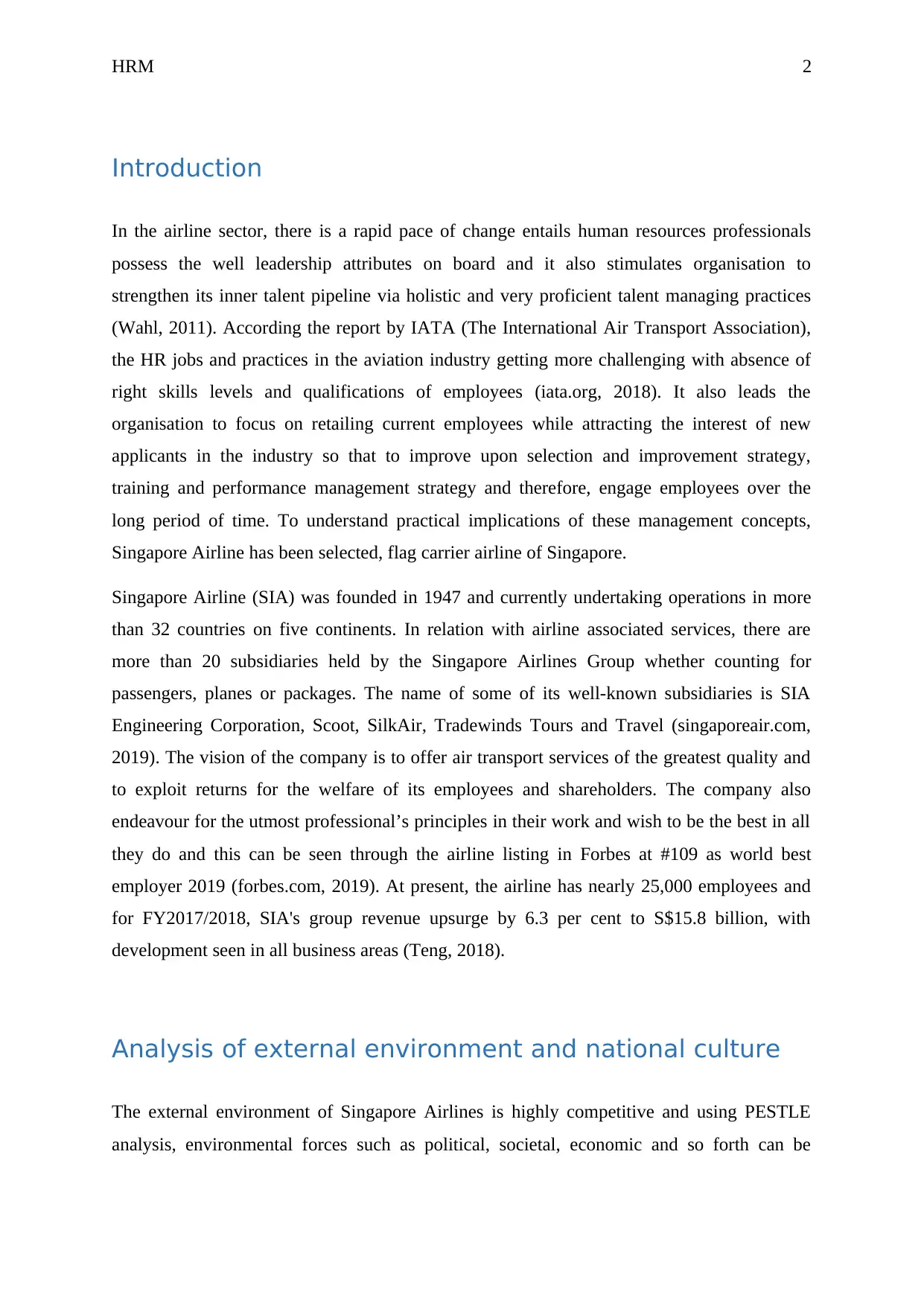
HRM 2
Introduction
In the airline sector, there is a rapid pace of change entails human resources professionals
possess the well leadership attributes on board and it also stimulates organisation to
strengthen its inner talent pipeline via holistic and very proficient talent managing practices
(Wahl, 2011). According the report by IATA (The International Air Transport Association),
the HR jobs and practices in the aviation industry getting more challenging with absence of
right skills levels and qualifications of employees (iata.org, 2018). It also leads the
organisation to focus on retailing current employees while attracting the interest of new
applicants in the industry so that to improve upon selection and improvement strategy,
training and performance management strategy and therefore, engage employees over the
long period of time. To understand practical implications of these management concepts,
Singapore Airline has been selected, flag carrier airline of Singapore.
Singapore Airline (SIA) was founded in 1947 and currently undertaking operations in more
than 32 countries on five continents. In relation with airline associated services, there are
more than 20 subsidiaries held by the Singapore Airlines Group whether counting for
passengers, planes or packages. The name of some of its well-known subsidiaries is SIA
Engineering Corporation, Scoot, SilkAir, Tradewinds Tours and Travel (singaporeair.com,
2019). The vision of the company is to offer air transport services of the greatest quality and
to exploit returns for the welfare of its employees and shareholders. The company also
endeavour for the utmost professional’s principles in their work and wish to be the best in all
they do and this can be seen through the airline listing in Forbes at #109 as world best
employer 2019 (forbes.com, 2019). At present, the airline has nearly 25,000 employees and
for FY2017/2018, SIA's group revenue upsurge by 6.3 per cent to S$15.8 billion, with
development seen in all business areas (Teng, 2018).
Analysis of external environment and national culture
The external environment of Singapore Airlines is highly competitive and using PESTLE
analysis, environmental forces such as political, societal, economic and so forth can be
Introduction
In the airline sector, there is a rapid pace of change entails human resources professionals
possess the well leadership attributes on board and it also stimulates organisation to
strengthen its inner talent pipeline via holistic and very proficient talent managing practices
(Wahl, 2011). According the report by IATA (The International Air Transport Association),
the HR jobs and practices in the aviation industry getting more challenging with absence of
right skills levels and qualifications of employees (iata.org, 2018). It also leads the
organisation to focus on retailing current employees while attracting the interest of new
applicants in the industry so that to improve upon selection and improvement strategy,
training and performance management strategy and therefore, engage employees over the
long period of time. To understand practical implications of these management concepts,
Singapore Airline has been selected, flag carrier airline of Singapore.
Singapore Airline (SIA) was founded in 1947 and currently undertaking operations in more
than 32 countries on five continents. In relation with airline associated services, there are
more than 20 subsidiaries held by the Singapore Airlines Group whether counting for
passengers, planes or packages. The name of some of its well-known subsidiaries is SIA
Engineering Corporation, Scoot, SilkAir, Tradewinds Tours and Travel (singaporeair.com,
2019). The vision of the company is to offer air transport services of the greatest quality and
to exploit returns for the welfare of its employees and shareholders. The company also
endeavour for the utmost professional’s principles in their work and wish to be the best in all
they do and this can be seen through the airline listing in Forbes at #109 as world best
employer 2019 (forbes.com, 2019). At present, the airline has nearly 25,000 employees and
for FY2017/2018, SIA's group revenue upsurge by 6.3 per cent to S$15.8 billion, with
development seen in all business areas (Teng, 2018).
Analysis of external environment and national culture
The external environment of Singapore Airlines is highly competitive and using PESTLE
analysis, environmental forces such as political, societal, economic and so forth can be
⊘ This is a preview!⊘
Do you want full access?
Subscribe today to unlock all pages.

Trusted by 1+ million students worldwide
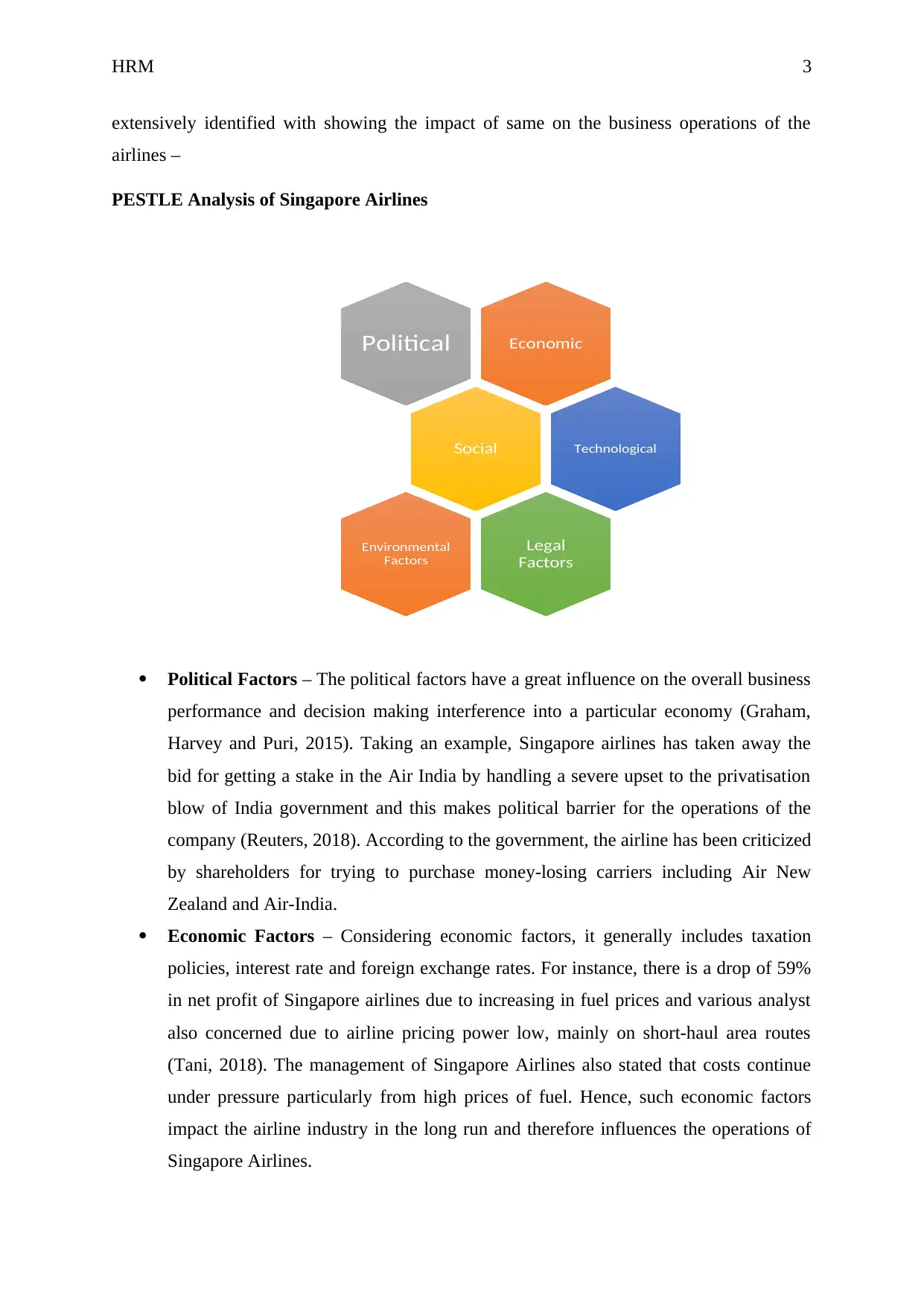
HRM 3
extensively identified with showing the impact of same on the business operations of the
airlines –
PESTLE Analysis of Singapore Airlines
Political Factors – The political factors have a great influence on the overall business
performance and decision making interference into a particular economy (Graham,
Harvey and Puri, 2015). Taking an example, Singapore airlines has taken away the
bid for getting a stake in the Air India by handling a severe upset to the privatisation
blow of India government and this makes political barrier for the operations of the
company (Reuters, 2018). According to the government, the airline has been criticized
by shareholders for trying to purchase money-losing carriers including Air New
Zealand and Air-India.
Economic Factors – Considering economic factors, it generally includes taxation
policies, interest rate and foreign exchange rates. For instance, there is a drop of 59%
in net profit of Singapore airlines due to increasing in fuel prices and various analyst
also concerned due to airline pricing power low, mainly on short-haul area routes
(Tani, 2018). The management of Singapore Airlines also stated that costs continue
under pressure particularly from high prices of fuel. Hence, such economic factors
impact the airline industry in the long run and therefore influences the operations of
Singapore Airlines.
EconomicPolitical
Social Technological
Legal
Factors
Environmental
Factors
extensively identified with showing the impact of same on the business operations of the
airlines –
PESTLE Analysis of Singapore Airlines
Political Factors – The political factors have a great influence on the overall business
performance and decision making interference into a particular economy (Graham,
Harvey and Puri, 2015). Taking an example, Singapore airlines has taken away the
bid for getting a stake in the Air India by handling a severe upset to the privatisation
blow of India government and this makes political barrier for the operations of the
company (Reuters, 2018). According to the government, the airline has been criticized
by shareholders for trying to purchase money-losing carriers including Air New
Zealand and Air-India.
Economic Factors – Considering economic factors, it generally includes taxation
policies, interest rate and foreign exchange rates. For instance, there is a drop of 59%
in net profit of Singapore airlines due to increasing in fuel prices and various analyst
also concerned due to airline pricing power low, mainly on short-haul area routes
(Tani, 2018). The management of Singapore Airlines also stated that costs continue
under pressure particularly from high prices of fuel. Hence, such economic factors
impact the airline industry in the long run and therefore influences the operations of
Singapore Airlines.
EconomicPolitical
Social Technological
Legal
Factors
Environmental
Factors
Paraphrase This Document
Need a fresh take? Get an instant paraphrase of this document with our AI Paraphraser
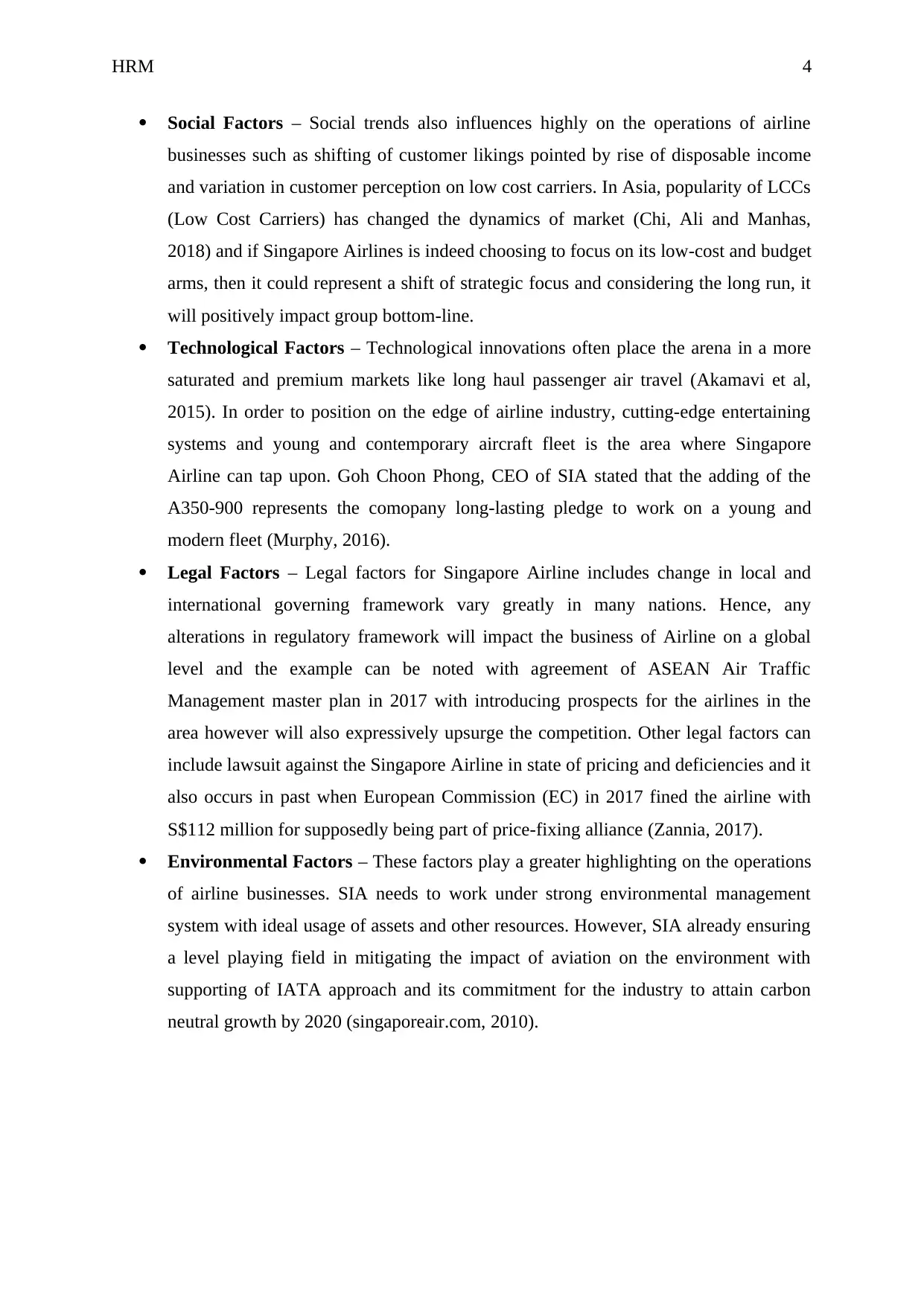
HRM 4
Social Factors – Social trends also influences highly on the operations of airline
businesses such as shifting of customer likings pointed by rise of disposable income
and variation in customer perception on low cost carriers. In Asia, popularity of LCCs
(Low Cost Carriers) has changed the dynamics of market (Chi, Ali and Manhas,
2018) and if Singapore Airlines is indeed choosing to focus on its low-cost and budget
arms, then it could represent a shift of strategic focus and considering the long run, it
will positively impact group bottom-line.
Technological Factors – Technological innovations often place the arena in a more
saturated and premium markets like long haul passenger air travel (Akamavi et al,
2015). In order to position on the edge of airline industry, cutting-edge entertaining
systems and young and contemporary aircraft fleet is the area where Singapore
Airline can tap upon. Goh Choon Phong, CEO of SIA stated that the adding of the
A350-900 represents the comopany long-lasting pledge to work on a young and
modern fleet (Murphy, 2016).
Legal Factors – Legal factors for Singapore Airline includes change in local and
international governing framework vary greatly in many nations. Hence, any
alterations in regulatory framework will impact the business of Airline on a global
level and the example can be noted with agreement of ASEAN Air Traffic
Management master plan in 2017 with introducing prospects for the airlines in the
area however will also expressively upsurge the competition. Other legal factors can
include lawsuit against the Singapore Airline in state of pricing and deficiencies and it
also occurs in past when European Commission (EC) in 2017 fined the airline with
S$112 million for supposedly being part of price-fixing alliance (Zannia, 2017).
Environmental Factors – These factors play a greater highlighting on the operations
of airline businesses. SIA needs to work under strong environmental management
system with ideal usage of assets and other resources. However, SIA already ensuring
a level playing field in mitigating the impact of aviation on the environment with
supporting of IATA approach and its commitment for the industry to attain carbon
neutral growth by 2020 (singaporeair.com, 2010).
Social Factors – Social trends also influences highly on the operations of airline
businesses such as shifting of customer likings pointed by rise of disposable income
and variation in customer perception on low cost carriers. In Asia, popularity of LCCs
(Low Cost Carriers) has changed the dynamics of market (Chi, Ali and Manhas,
2018) and if Singapore Airlines is indeed choosing to focus on its low-cost and budget
arms, then it could represent a shift of strategic focus and considering the long run, it
will positively impact group bottom-line.
Technological Factors – Technological innovations often place the arena in a more
saturated and premium markets like long haul passenger air travel (Akamavi et al,
2015). In order to position on the edge of airline industry, cutting-edge entertaining
systems and young and contemporary aircraft fleet is the area where Singapore
Airline can tap upon. Goh Choon Phong, CEO of SIA stated that the adding of the
A350-900 represents the comopany long-lasting pledge to work on a young and
modern fleet (Murphy, 2016).
Legal Factors – Legal factors for Singapore Airline includes change in local and
international governing framework vary greatly in many nations. Hence, any
alterations in regulatory framework will impact the business of Airline on a global
level and the example can be noted with agreement of ASEAN Air Traffic
Management master plan in 2017 with introducing prospects for the airlines in the
area however will also expressively upsurge the competition. Other legal factors can
include lawsuit against the Singapore Airline in state of pricing and deficiencies and it
also occurs in past when European Commission (EC) in 2017 fined the airline with
S$112 million for supposedly being part of price-fixing alliance (Zannia, 2017).
Environmental Factors – These factors play a greater highlighting on the operations
of airline businesses. SIA needs to work under strong environmental management
system with ideal usage of assets and other resources. However, SIA already ensuring
a level playing field in mitigating the impact of aviation on the environment with
supporting of IATA approach and its commitment for the industry to attain carbon
neutral growth by 2020 (singaporeair.com, 2010).
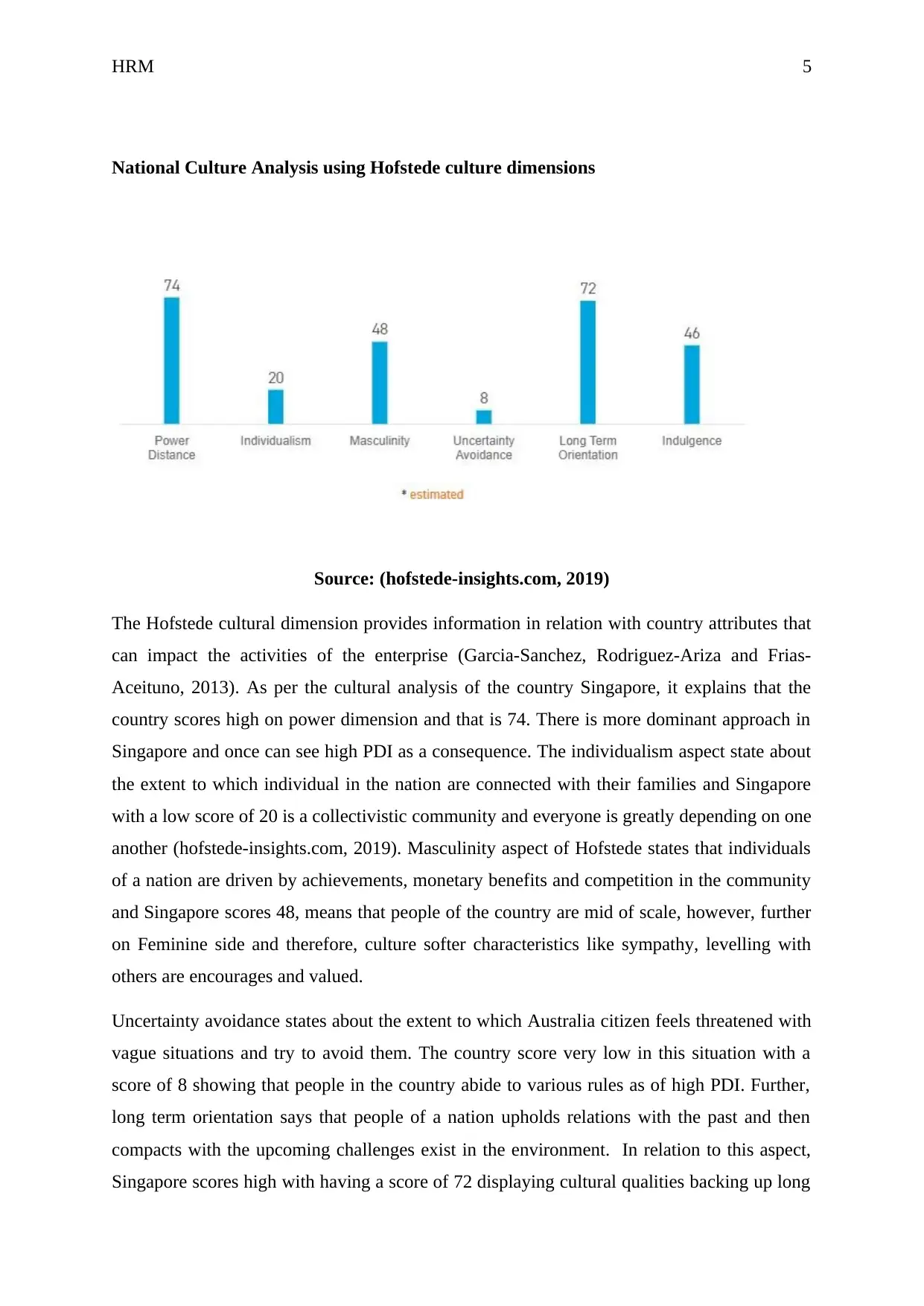
HRM 5
National Culture Analysis using Hofstede culture dimensions
Source: (hofstede-insights.com, 2019)
The Hofstede cultural dimension provides information in relation with country attributes that
can impact the activities of the enterprise (Garcia-Sanchez, Rodriguez-Ariza and Frias-
Aceituno, 2013). As per the cultural analysis of the country Singapore, it explains that the
country scores high on power dimension and that is 74. There is more dominant approach in
Singapore and once can see high PDI as a consequence. The individualism aspect state about
the extent to which individual in the nation are connected with their families and Singapore
with a low score of 20 is a collectivistic community and everyone is greatly depending on one
another (hofstede-insights.com, 2019). Masculinity aspect of Hofstede states that individuals
of a nation are driven by achievements, monetary benefits and competition in the community
and Singapore scores 48, means that people of the country are mid of scale, however, further
on Feminine side and therefore, culture softer characteristics like sympathy, levelling with
others are encourages and valued.
Uncertainty avoidance states about the extent to which Australia citizen feels threatened with
vague situations and try to avoid them. The country score very low in this situation with a
score of 8 showing that people in the country abide to various rules as of high PDI. Further,
long term orientation says that people of a nation upholds relations with the past and then
compacts with the upcoming challenges exist in the environment. In relation to this aspect,
Singapore scores high with having a score of 72 displaying cultural qualities backing up long
National Culture Analysis using Hofstede culture dimensions
Source: (hofstede-insights.com, 2019)
The Hofstede cultural dimension provides information in relation with country attributes that
can impact the activities of the enterprise (Garcia-Sanchez, Rodriguez-Ariza and Frias-
Aceituno, 2013). As per the cultural analysis of the country Singapore, it explains that the
country scores high on power dimension and that is 74. There is more dominant approach in
Singapore and once can see high PDI as a consequence. The individualism aspect state about
the extent to which individual in the nation are connected with their families and Singapore
with a low score of 20 is a collectivistic community and everyone is greatly depending on one
another (hofstede-insights.com, 2019). Masculinity aspect of Hofstede states that individuals
of a nation are driven by achievements, monetary benefits and competition in the community
and Singapore scores 48, means that people of the country are mid of scale, however, further
on Feminine side and therefore, culture softer characteristics like sympathy, levelling with
others are encourages and valued.
Uncertainty avoidance states about the extent to which Australia citizen feels threatened with
vague situations and try to avoid them. The country score very low in this situation with a
score of 8 showing that people in the country abide to various rules as of high PDI. Further,
long term orientation says that people of a nation upholds relations with the past and then
compacts with the upcoming challenges exist in the environment. In relation to this aspect,
Singapore scores high with having a score of 72 displaying cultural qualities backing up long
⊘ This is a preview!⊘
Do you want full access?
Subscribe today to unlock all pages.

Trusted by 1+ million students worldwide
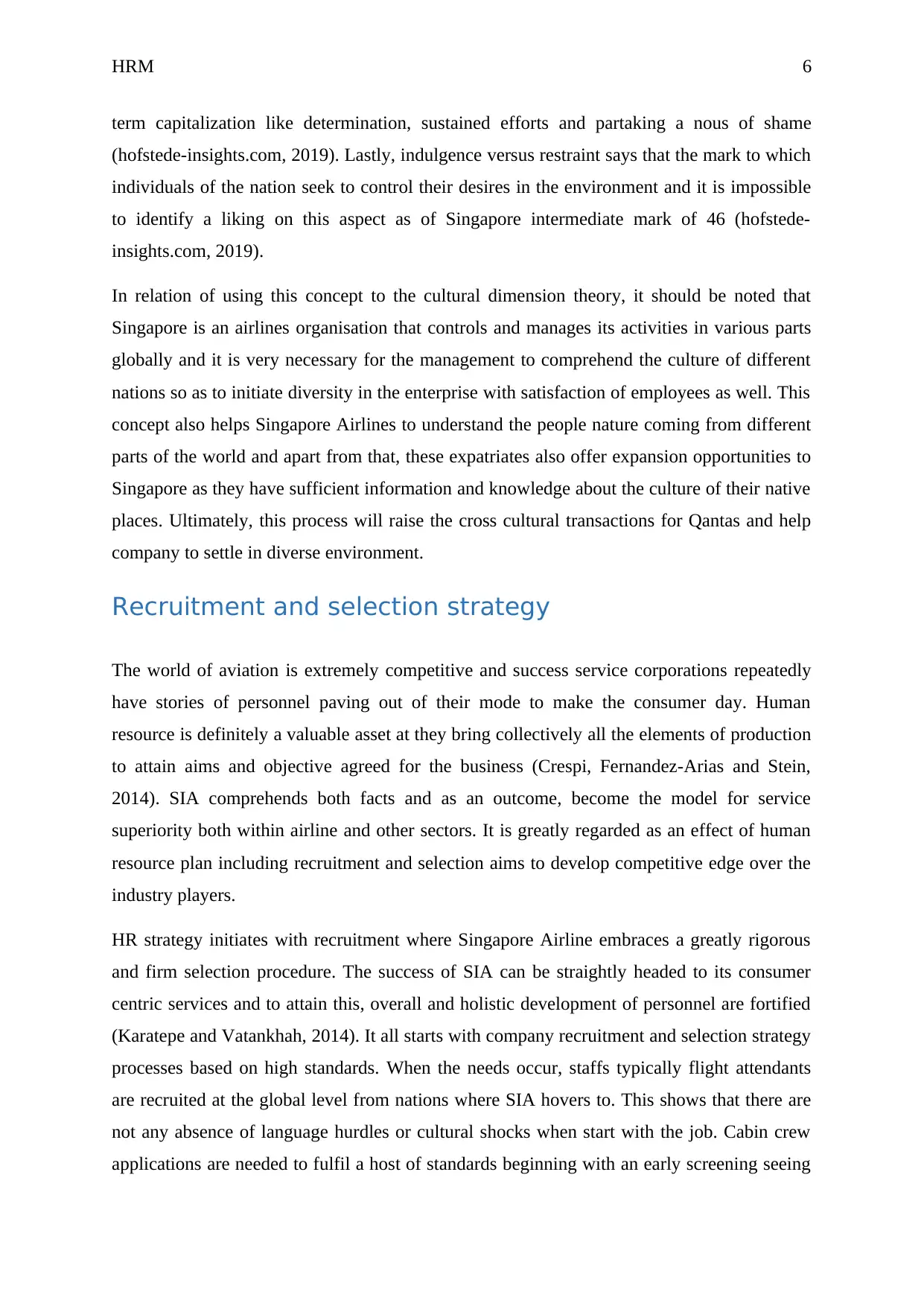
HRM 6
term capitalization like determination, sustained efforts and partaking a nous of shame
(hofstede-insights.com, 2019). Lastly, indulgence versus restraint says that the mark to which
individuals of the nation seek to control their desires in the environment and it is impossible
to identify a liking on this aspect as of Singapore intermediate mark of 46 (hofstede-
insights.com, 2019).
In relation of using this concept to the cultural dimension theory, it should be noted that
Singapore is an airlines organisation that controls and manages its activities in various parts
globally and it is very necessary for the management to comprehend the culture of different
nations so as to initiate diversity in the enterprise with satisfaction of employees as well. This
concept also helps Singapore Airlines to understand the people nature coming from different
parts of the world and apart from that, these expatriates also offer expansion opportunities to
Singapore as they have sufficient information and knowledge about the culture of their native
places. Ultimately, this process will raise the cross cultural transactions for Qantas and help
company to settle in diverse environment.
Recruitment and selection strategy
The world of aviation is extremely competitive and success service corporations repeatedly
have stories of personnel paving out of their mode to make the consumer day. Human
resource is definitely a valuable asset at they bring collectively all the elements of production
to attain aims and objective agreed for the business (Crespi, Fernandez-Arias and Stein,
2014). SIA comprehends both facts and as an outcome, become the model for service
superiority both within airline and other sectors. It is greatly regarded as an effect of human
resource plan including recruitment and selection aims to develop competitive edge over the
industry players.
HR strategy initiates with recruitment where Singapore Airline embraces a greatly rigorous
and firm selection procedure. The success of SIA can be straightly headed to its consumer
centric services and to attain this, overall and holistic development of personnel are fortified
(Karatepe and Vatankhah, 2014). It all starts with company recruitment and selection strategy
processes based on high standards. When the needs occur, staffs typically flight attendants
are recruited at the global level from nations where SIA hovers to. This shows that there are
not any absence of language hurdles or cultural shocks when start with the job. Cabin crew
applications are needed to fulfil a host of standards beginning with an early screening seeing
term capitalization like determination, sustained efforts and partaking a nous of shame
(hofstede-insights.com, 2019). Lastly, indulgence versus restraint says that the mark to which
individuals of the nation seek to control their desires in the environment and it is impossible
to identify a liking on this aspect as of Singapore intermediate mark of 46 (hofstede-
insights.com, 2019).
In relation of using this concept to the cultural dimension theory, it should be noted that
Singapore is an airlines organisation that controls and manages its activities in various parts
globally and it is very necessary for the management to comprehend the culture of different
nations so as to initiate diversity in the enterprise with satisfaction of employees as well. This
concept also helps Singapore Airlines to understand the people nature coming from different
parts of the world and apart from that, these expatriates also offer expansion opportunities to
Singapore as they have sufficient information and knowledge about the culture of their native
places. Ultimately, this process will raise the cross cultural transactions for Qantas and help
company to settle in diverse environment.
Recruitment and selection strategy
The world of aviation is extremely competitive and success service corporations repeatedly
have stories of personnel paving out of their mode to make the consumer day. Human
resource is definitely a valuable asset at they bring collectively all the elements of production
to attain aims and objective agreed for the business (Crespi, Fernandez-Arias and Stein,
2014). SIA comprehends both facts and as an outcome, become the model for service
superiority both within airline and other sectors. It is greatly regarded as an effect of human
resource plan including recruitment and selection aims to develop competitive edge over the
industry players.
HR strategy initiates with recruitment where Singapore Airline embraces a greatly rigorous
and firm selection procedure. The success of SIA can be straightly headed to its consumer
centric services and to attain this, overall and holistic development of personnel are fortified
(Karatepe and Vatankhah, 2014). It all starts with company recruitment and selection strategy
processes based on high standards. When the needs occur, staffs typically flight attendants
are recruited at the global level from nations where SIA hovers to. This shows that there are
not any absence of language hurdles or cultural shocks when start with the job. Cabin crew
applications are needed to fulfil a host of standards beginning with an early screening seeing
Paraphrase This Document
Need a fresh take? Get an instant paraphrase of this document with our AI Paraphraser
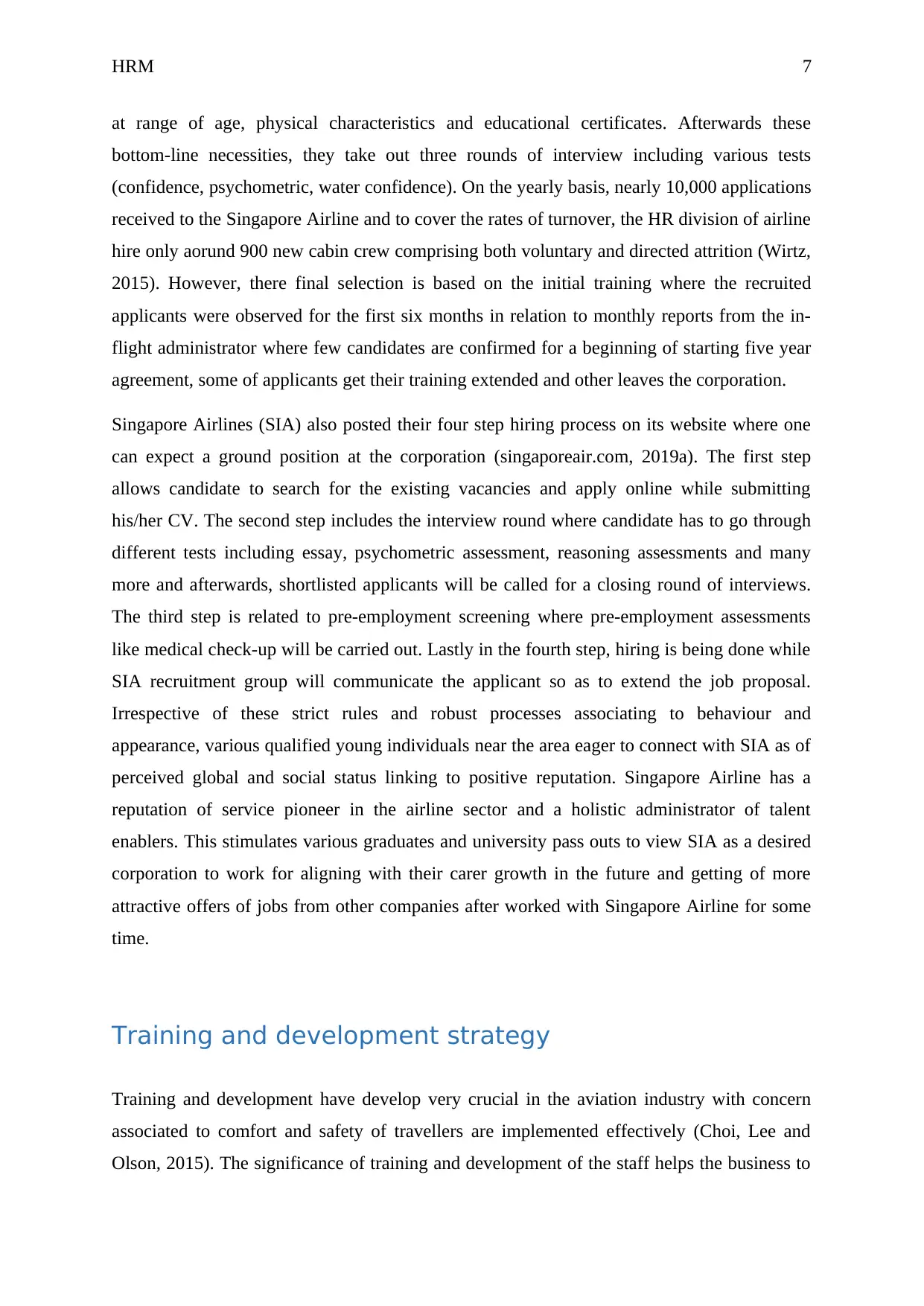
HRM 7
at range of age, physical characteristics and educational certificates. Afterwards these
bottom-line necessities, they take out three rounds of interview including various tests
(confidence, psychometric, water confidence). On the yearly basis, nearly 10,000 applications
received to the Singapore Airline and to cover the rates of turnover, the HR division of airline
hire only aorund 900 new cabin crew comprising both voluntary and directed attrition (Wirtz,
2015). However, there final selection is based on the initial training where the recruited
applicants were observed for the first six months in relation to monthly reports from the in-
flight administrator where few candidates are confirmed for a beginning of starting five year
agreement, some of applicants get their training extended and other leaves the corporation.
Singapore Airlines (SIA) also posted their four step hiring process on its website where one
can expect a ground position at the corporation (singaporeair.com, 2019a). The first step
allows candidate to search for the existing vacancies and apply online while submitting
his/her CV. The second step includes the interview round where candidate has to go through
different tests including essay, psychometric assessment, reasoning assessments and many
more and afterwards, shortlisted applicants will be called for a closing round of interviews.
The third step is related to pre-employment screening where pre-employment assessments
like medical check-up will be carried out. Lastly in the fourth step, hiring is being done while
SIA recruitment group will communicate the applicant so as to extend the job proposal.
Irrespective of these strict rules and robust processes associating to behaviour and
appearance, various qualified young individuals near the area eager to connect with SIA as of
perceived global and social status linking to positive reputation. Singapore Airline has a
reputation of service pioneer in the airline sector and a holistic administrator of talent
enablers. This stimulates various graduates and university pass outs to view SIA as a desired
corporation to work for aligning with their carer growth in the future and getting of more
attractive offers of jobs from other companies after worked with Singapore Airline for some
time.
Training and development strategy
Training and development have develop very crucial in the aviation industry with concern
associated to comfort and safety of travellers are implemented effectively (Choi, Lee and
Olson, 2015). The significance of training and development of the staff helps the business to
at range of age, physical characteristics and educational certificates. Afterwards these
bottom-line necessities, they take out three rounds of interview including various tests
(confidence, psychometric, water confidence). On the yearly basis, nearly 10,000 applications
received to the Singapore Airline and to cover the rates of turnover, the HR division of airline
hire only aorund 900 new cabin crew comprising both voluntary and directed attrition (Wirtz,
2015). However, there final selection is based on the initial training where the recruited
applicants were observed for the first six months in relation to monthly reports from the in-
flight administrator where few candidates are confirmed for a beginning of starting five year
agreement, some of applicants get their training extended and other leaves the corporation.
Singapore Airlines (SIA) also posted their four step hiring process on its website where one
can expect a ground position at the corporation (singaporeair.com, 2019a). The first step
allows candidate to search for the existing vacancies and apply online while submitting
his/her CV. The second step includes the interview round where candidate has to go through
different tests including essay, psychometric assessment, reasoning assessments and many
more and afterwards, shortlisted applicants will be called for a closing round of interviews.
The third step is related to pre-employment screening where pre-employment assessments
like medical check-up will be carried out. Lastly in the fourth step, hiring is being done while
SIA recruitment group will communicate the applicant so as to extend the job proposal.
Irrespective of these strict rules and robust processes associating to behaviour and
appearance, various qualified young individuals near the area eager to connect with SIA as of
perceived global and social status linking to positive reputation. Singapore Airline has a
reputation of service pioneer in the airline sector and a holistic administrator of talent
enablers. This stimulates various graduates and university pass outs to view SIA as a desired
corporation to work for aligning with their carer growth in the future and getting of more
attractive offers of jobs from other companies after worked with Singapore Airline for some
time.
Training and development strategy
Training and development have develop very crucial in the aviation industry with concern
associated to comfort and safety of travellers are implemented effectively (Choi, Lee and
Olson, 2015). The significance of training and development of the staff helps the business to
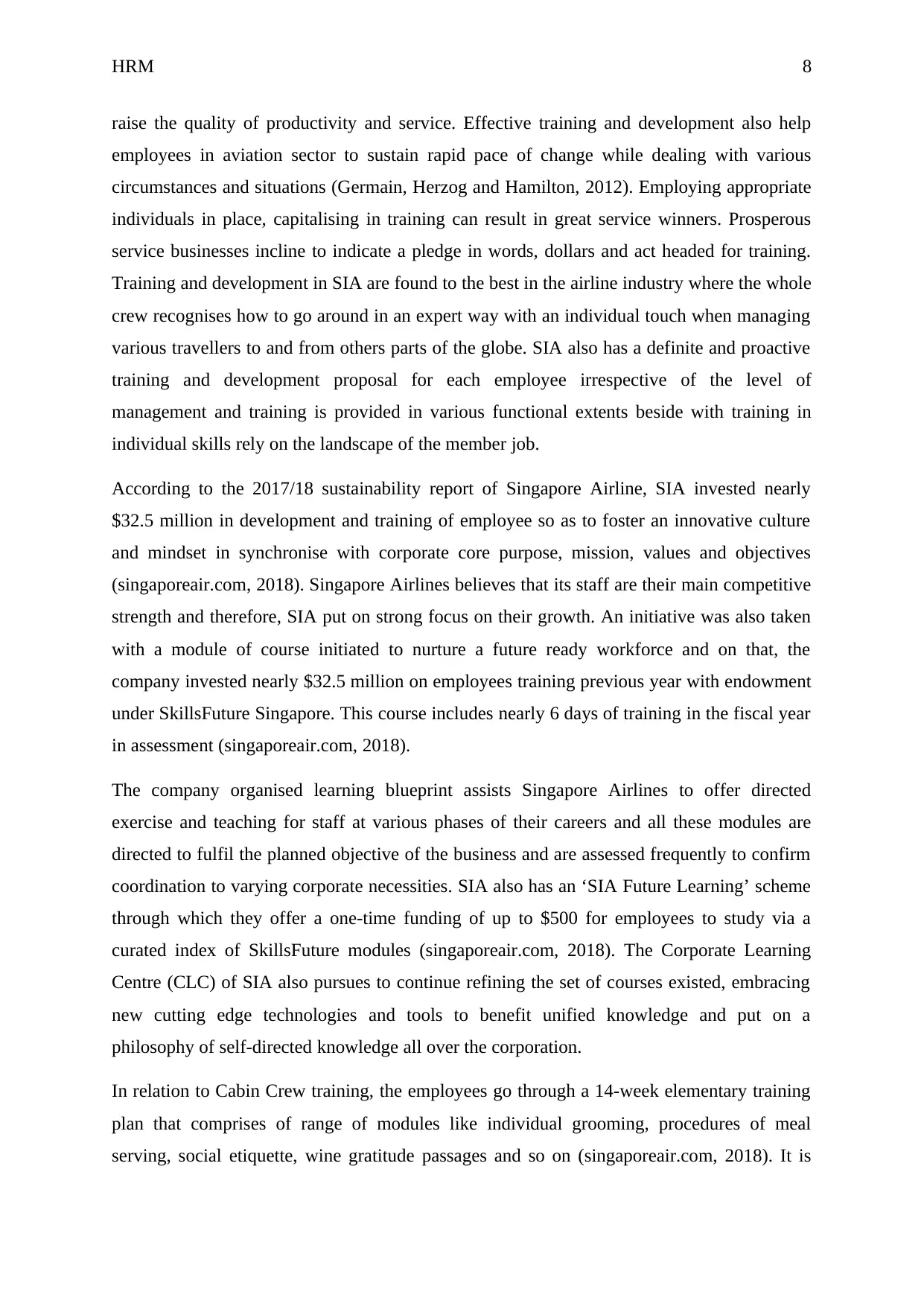
HRM 8
raise the quality of productivity and service. Effective training and development also help
employees in aviation sector to sustain rapid pace of change while dealing with various
circumstances and situations (Germain, Herzog and Hamilton, 2012). Employing appropriate
individuals in place, capitalising in training can result in great service winners. Prosperous
service businesses incline to indicate a pledge in words, dollars and act headed for training.
Training and development in SIA are found to the best in the airline industry where the whole
crew recognises how to go around in an expert way with an individual touch when managing
various travellers to and from others parts of the globe. SIA also has a definite and proactive
training and development proposal for each employee irrespective of the level of
management and training is provided in various functional extents beside with training in
individual skills rely on the landscape of the member job.
According to the 2017/18 sustainability report of Singapore Airline, SIA invested nearly
$32.5 million in development and training of employee so as to foster an innovative culture
and mindset in synchronise with corporate core purpose, mission, values and objectives
(singaporeair.com, 2018). Singapore Airlines believes that its staff are their main competitive
strength and therefore, SIA put on strong focus on their growth. An initiative was also taken
with a module of course initiated to nurture a future ready workforce and on that, the
company invested nearly $32.5 million on employees training previous year with endowment
under SkillsFuture Singapore. This course includes nearly 6 days of training in the fiscal year
in assessment (singaporeair.com, 2018).
The company organised learning blueprint assists Singapore Airlines to offer directed
exercise and teaching for staff at various phases of their careers and all these modules are
directed to fulfil the planned objective of the business and are assessed frequently to confirm
coordination to varying corporate necessities. SIA also has an ‘SIA Future Learning’ scheme
through which they offer a one-time funding of up to $500 for employees to study via a
curated index of SkillsFuture modules (singaporeair.com, 2018). The Corporate Learning
Centre (CLC) of SIA also pursues to continue refining the set of courses existed, embracing
new cutting edge technologies and tools to benefit unified knowledge and put on a
philosophy of self-directed knowledge all over the corporation.
In relation to Cabin Crew training, the employees go through a 14-week elementary training
plan that comprises of range of modules like individual grooming, procedures of meal
serving, social etiquette, wine gratitude passages and so on (singaporeair.com, 2018). It is
raise the quality of productivity and service. Effective training and development also help
employees in aviation sector to sustain rapid pace of change while dealing with various
circumstances and situations (Germain, Herzog and Hamilton, 2012). Employing appropriate
individuals in place, capitalising in training can result in great service winners. Prosperous
service businesses incline to indicate a pledge in words, dollars and act headed for training.
Training and development in SIA are found to the best in the airline industry where the whole
crew recognises how to go around in an expert way with an individual touch when managing
various travellers to and from others parts of the globe. SIA also has a definite and proactive
training and development proposal for each employee irrespective of the level of
management and training is provided in various functional extents beside with training in
individual skills rely on the landscape of the member job.
According to the 2017/18 sustainability report of Singapore Airline, SIA invested nearly
$32.5 million in development and training of employee so as to foster an innovative culture
and mindset in synchronise with corporate core purpose, mission, values and objectives
(singaporeair.com, 2018). Singapore Airlines believes that its staff are their main competitive
strength and therefore, SIA put on strong focus on their growth. An initiative was also taken
with a module of course initiated to nurture a future ready workforce and on that, the
company invested nearly $32.5 million on employees training previous year with endowment
under SkillsFuture Singapore. This course includes nearly 6 days of training in the fiscal year
in assessment (singaporeair.com, 2018).
The company organised learning blueprint assists Singapore Airlines to offer directed
exercise and teaching for staff at various phases of their careers and all these modules are
directed to fulfil the planned objective of the business and are assessed frequently to confirm
coordination to varying corporate necessities. SIA also has an ‘SIA Future Learning’ scheme
through which they offer a one-time funding of up to $500 for employees to study via a
curated index of SkillsFuture modules (singaporeair.com, 2018). The Corporate Learning
Centre (CLC) of SIA also pursues to continue refining the set of courses existed, embracing
new cutting edge technologies and tools to benefit unified knowledge and put on a
philosophy of self-directed knowledge all over the corporation.
In relation to Cabin Crew training, the employees go through a 14-week elementary training
plan that comprises of range of modules like individual grooming, procedures of meal
serving, social etiquette, wine gratitude passages and so on (singaporeair.com, 2018). It is
⊘ This is a preview!⊘
Do you want full access?
Subscribe today to unlock all pages.

Trusted by 1+ million students worldwide
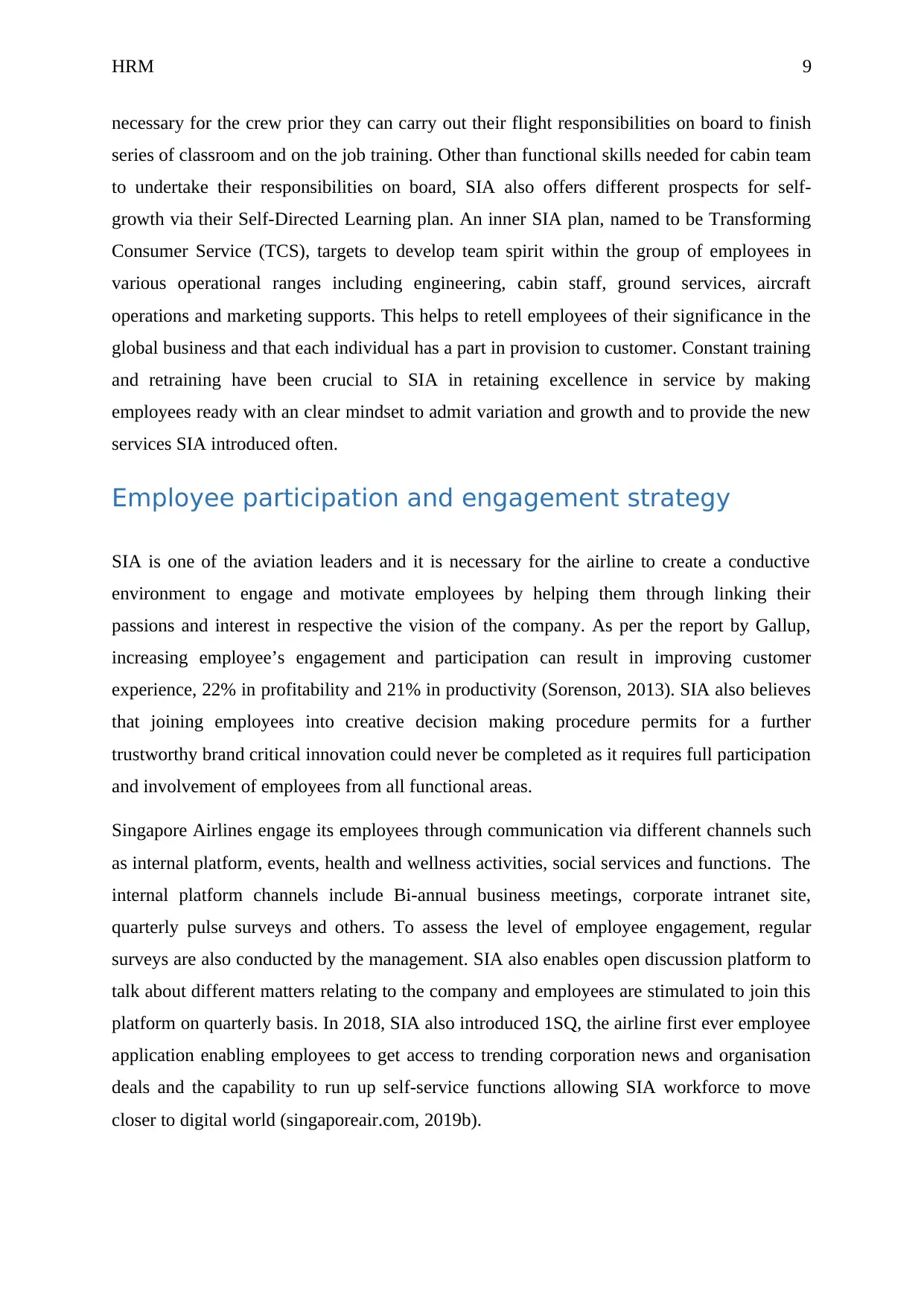
HRM 9
necessary for the crew prior they can carry out their flight responsibilities on board to finish
series of classroom and on the job training. Other than functional skills needed for cabin team
to undertake their responsibilities on board, SIA also offers different prospects for self-
growth via their Self-Directed Learning plan. An inner SIA plan, named to be Transforming
Consumer Service (TCS), targets to develop team spirit within the group of employees in
various operational ranges including engineering, cabin staff, ground services, aircraft
operations and marketing supports. This helps to retell employees of their significance in the
global business and that each individual has a part in provision to customer. Constant training
and retraining have been crucial to SIA in retaining excellence in service by making
employees ready with an clear mindset to admit variation and growth and to provide the new
services SIA introduced often.
Employee participation and engagement strategy
SIA is one of the aviation leaders and it is necessary for the airline to create a conductive
environment to engage and motivate employees by helping them through linking their
passions and interest in respective the vision of the company. As per the report by Gallup,
increasing employee’s engagement and participation can result in improving customer
experience, 22% in profitability and 21% in productivity (Sorenson, 2013). SIA also believes
that joining employees into creative decision making procedure permits for a further
trustworthy brand critical innovation could never be completed as it requires full participation
and involvement of employees from all functional areas.
Singapore Airlines engage its employees through communication via different channels such
as internal platform, events, health and wellness activities, social services and functions. The
internal platform channels include Bi-annual business meetings, corporate intranet site,
quarterly pulse surveys and others. To assess the level of employee engagement, regular
surveys are also conducted by the management. SIA also enables open discussion platform to
talk about different matters relating to the company and employees are stimulated to join this
platform on quarterly basis. In 2018, SIA also introduced 1SQ, the airline first ever employee
application enabling employees to get access to trending corporation news and organisation
deals and the capability to run up self-service functions allowing SIA workforce to move
closer to digital world (singaporeair.com, 2019b).
necessary for the crew prior they can carry out their flight responsibilities on board to finish
series of classroom and on the job training. Other than functional skills needed for cabin team
to undertake their responsibilities on board, SIA also offers different prospects for self-
growth via their Self-Directed Learning plan. An inner SIA plan, named to be Transforming
Consumer Service (TCS), targets to develop team spirit within the group of employees in
various operational ranges including engineering, cabin staff, ground services, aircraft
operations and marketing supports. This helps to retell employees of their significance in the
global business and that each individual has a part in provision to customer. Constant training
and retraining have been crucial to SIA in retaining excellence in service by making
employees ready with an clear mindset to admit variation and growth and to provide the new
services SIA introduced often.
Employee participation and engagement strategy
SIA is one of the aviation leaders and it is necessary for the airline to create a conductive
environment to engage and motivate employees by helping them through linking their
passions and interest in respective the vision of the company. As per the report by Gallup,
increasing employee’s engagement and participation can result in improving customer
experience, 22% in profitability and 21% in productivity (Sorenson, 2013). SIA also believes
that joining employees into creative decision making procedure permits for a further
trustworthy brand critical innovation could never be completed as it requires full participation
and involvement of employees from all functional areas.
Singapore Airlines engage its employees through communication via different channels such
as internal platform, events, health and wellness activities, social services and functions. The
internal platform channels include Bi-annual business meetings, corporate intranet site,
quarterly pulse surveys and others. To assess the level of employee engagement, regular
surveys are also conducted by the management. SIA also enables open discussion platform to
talk about different matters relating to the company and employees are stimulated to join this
platform on quarterly basis. In 2018, SIA also introduced 1SQ, the airline first ever employee
application enabling employees to get access to trending corporation news and organisation
deals and the capability to run up self-service functions allowing SIA workforce to move
closer to digital world (singaporeair.com, 2019b).
Paraphrase This Document
Need a fresh take? Get an instant paraphrase of this document with our AI Paraphraser
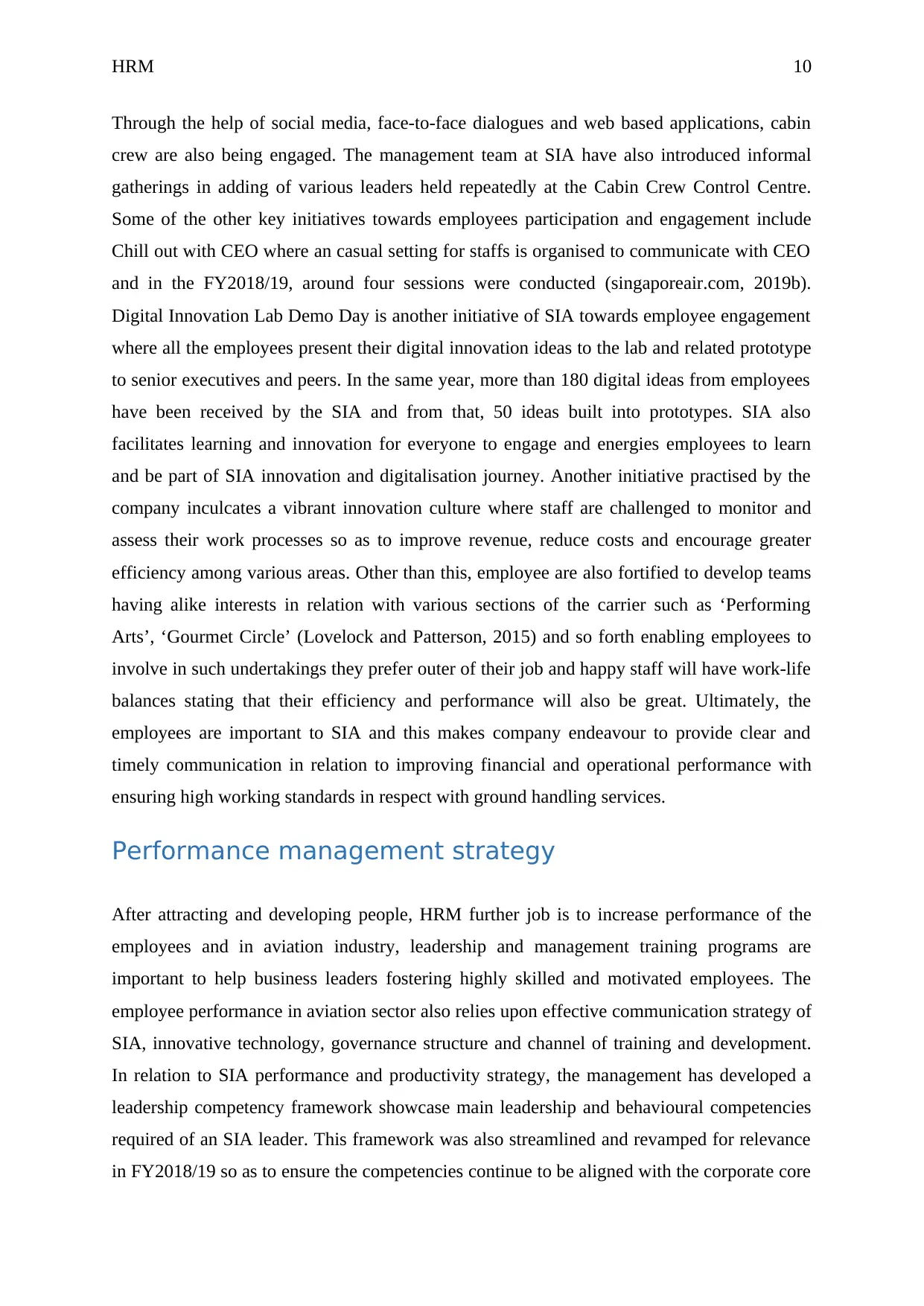
HRM 10
Through the help of social media, face-to-face dialogues and web based applications, cabin
crew are also being engaged. The management team at SIA have also introduced informal
gatherings in adding of various leaders held repeatedly at the Cabin Crew Control Centre.
Some of the other key initiatives towards employees participation and engagement include
Chill out with CEO where an casual setting for staffs is organised to communicate with CEO
and in the FY2018/19, around four sessions were conducted (singaporeair.com, 2019b).
Digital Innovation Lab Demo Day is another initiative of SIA towards employee engagement
where all the employees present their digital innovation ideas to the lab and related prototype
to senior executives and peers. In the same year, more than 180 digital ideas from employees
have been received by the SIA and from that, 50 ideas built into prototypes. SIA also
facilitates learning and innovation for everyone to engage and energies employees to learn
and be part of SIA innovation and digitalisation journey. Another initiative practised by the
company inculcates a vibrant innovation culture where staff are challenged to monitor and
assess their work processes so as to improve revenue, reduce costs and encourage greater
efficiency among various areas. Other than this, employee are also fortified to develop teams
having alike interests in relation with various sections of the carrier such as ‘Performing
Arts’, ‘Gourmet Circle’ (Lovelock and Patterson, 2015) and so forth enabling employees to
involve in such undertakings they prefer outer of their job and happy staff will have work-life
balances stating that their efficiency and performance will also be great. Ultimately, the
employees are important to SIA and this makes company endeavour to provide clear and
timely communication in relation to improving financial and operational performance with
ensuring high working standards in respect with ground handling services.
Performance management strategy
After attracting and developing people, HRM further job is to increase performance of the
employees and in aviation industry, leadership and management training programs are
important to help business leaders fostering highly skilled and motivated employees. The
employee performance in aviation sector also relies upon effective communication strategy of
SIA, innovative technology, governance structure and channel of training and development.
In relation to SIA performance and productivity strategy, the management has developed a
leadership competency framework showcase main leadership and behavioural competencies
required of an SIA leader. This framework was also streamlined and revamped for relevance
in FY2018/19 so as to ensure the competencies continue to be aligned with the corporate core
Through the help of social media, face-to-face dialogues and web based applications, cabin
crew are also being engaged. The management team at SIA have also introduced informal
gatherings in adding of various leaders held repeatedly at the Cabin Crew Control Centre.
Some of the other key initiatives towards employees participation and engagement include
Chill out with CEO where an casual setting for staffs is organised to communicate with CEO
and in the FY2018/19, around four sessions were conducted (singaporeair.com, 2019b).
Digital Innovation Lab Demo Day is another initiative of SIA towards employee engagement
where all the employees present their digital innovation ideas to the lab and related prototype
to senior executives and peers. In the same year, more than 180 digital ideas from employees
have been received by the SIA and from that, 50 ideas built into prototypes. SIA also
facilitates learning and innovation for everyone to engage and energies employees to learn
and be part of SIA innovation and digitalisation journey. Another initiative practised by the
company inculcates a vibrant innovation culture where staff are challenged to monitor and
assess their work processes so as to improve revenue, reduce costs and encourage greater
efficiency among various areas. Other than this, employee are also fortified to develop teams
having alike interests in relation with various sections of the carrier such as ‘Performing
Arts’, ‘Gourmet Circle’ (Lovelock and Patterson, 2015) and so forth enabling employees to
involve in such undertakings they prefer outer of their job and happy staff will have work-life
balances stating that their efficiency and performance will also be great. Ultimately, the
employees are important to SIA and this makes company endeavour to provide clear and
timely communication in relation to improving financial and operational performance with
ensuring high working standards in respect with ground handling services.
Performance management strategy
After attracting and developing people, HRM further job is to increase performance of the
employees and in aviation industry, leadership and management training programs are
important to help business leaders fostering highly skilled and motivated employees. The
employee performance in aviation sector also relies upon effective communication strategy of
SIA, innovative technology, governance structure and channel of training and development.
In relation to SIA performance and productivity strategy, the management has developed a
leadership competency framework showcase main leadership and behavioural competencies
required of an SIA leader. This framework was also streamlined and revamped for relevance
in FY2018/19 so as to ensure the competencies continue to be aligned with the corporate core
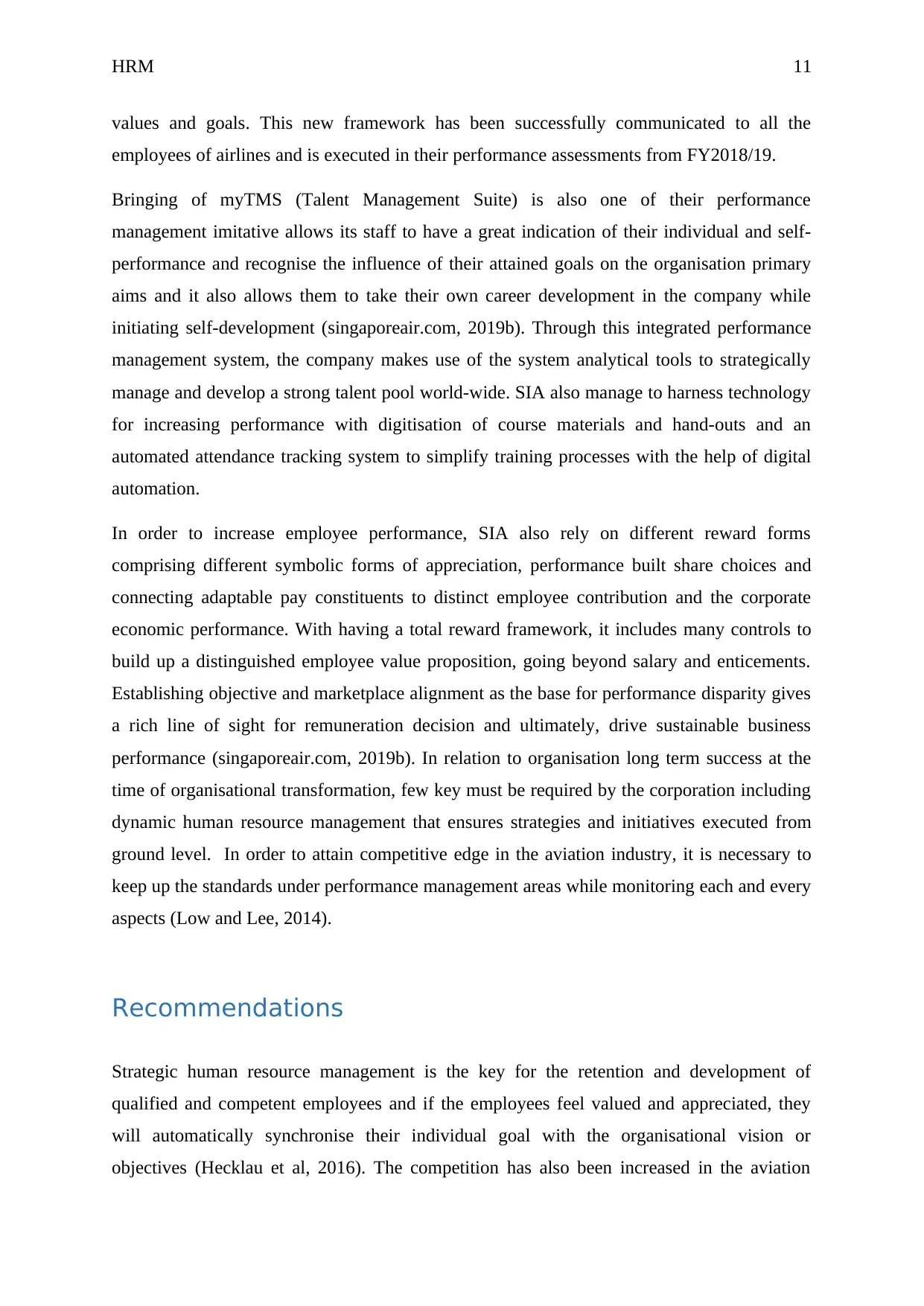
HRM 11
values and goals. This new framework has been successfully communicated to all the
employees of airlines and is executed in their performance assessments from FY2018/19.
Bringing of myTMS (Talent Management Suite) is also one of their performance
management imitative allows its staff to have a great indication of their individual and self-
performance and recognise the influence of their attained goals on the organisation primary
aims and it also allows them to take their own career development in the company while
initiating self-development (singaporeair.com, 2019b). Through this integrated performance
management system, the company makes use of the system analytical tools to strategically
manage and develop a strong talent pool world-wide. SIA also manage to harness technology
for increasing performance with digitisation of course materials and hand-outs and an
automated attendance tracking system to simplify training processes with the help of digital
automation.
In order to increase employee performance, SIA also rely on different reward forms
comprising different symbolic forms of appreciation, performance built share choices and
connecting adaptable pay constituents to distinct employee contribution and the corporate
economic performance. With having a total reward framework, it includes many controls to
build up a distinguished employee value proposition, going beyond salary and enticements.
Establishing objective and marketplace alignment as the base for performance disparity gives
a rich line of sight for remuneration decision and ultimately, drive sustainable business
performance (singaporeair.com, 2019b). In relation to organisation long term success at the
time of organisational transformation, few key must be required by the corporation including
dynamic human resource management that ensures strategies and initiatives executed from
ground level. In order to attain competitive edge in the aviation industry, it is necessary to
keep up the standards under performance management areas while monitoring each and every
aspects (Low and Lee, 2014).
Recommendations
Strategic human resource management is the key for the retention and development of
qualified and competent employees and if the employees feel valued and appreciated, they
will automatically synchronise their individual goal with the organisational vision or
objectives (Hecklau et al, 2016). The competition has also been increased in the aviation
values and goals. This new framework has been successfully communicated to all the
employees of airlines and is executed in their performance assessments from FY2018/19.
Bringing of myTMS (Talent Management Suite) is also one of their performance
management imitative allows its staff to have a great indication of their individual and self-
performance and recognise the influence of their attained goals on the organisation primary
aims and it also allows them to take their own career development in the company while
initiating self-development (singaporeair.com, 2019b). Through this integrated performance
management system, the company makes use of the system analytical tools to strategically
manage and develop a strong talent pool world-wide. SIA also manage to harness technology
for increasing performance with digitisation of course materials and hand-outs and an
automated attendance tracking system to simplify training processes with the help of digital
automation.
In order to increase employee performance, SIA also rely on different reward forms
comprising different symbolic forms of appreciation, performance built share choices and
connecting adaptable pay constituents to distinct employee contribution and the corporate
economic performance. With having a total reward framework, it includes many controls to
build up a distinguished employee value proposition, going beyond salary and enticements.
Establishing objective and marketplace alignment as the base for performance disparity gives
a rich line of sight for remuneration decision and ultimately, drive sustainable business
performance (singaporeair.com, 2019b). In relation to organisation long term success at the
time of organisational transformation, few key must be required by the corporation including
dynamic human resource management that ensures strategies and initiatives executed from
ground level. In order to attain competitive edge in the aviation industry, it is necessary to
keep up the standards under performance management areas while monitoring each and every
aspects (Low and Lee, 2014).
Recommendations
Strategic human resource management is the key for the retention and development of
qualified and competent employees and if the employees feel valued and appreciated, they
will automatically synchronise their individual goal with the organisational vision or
objectives (Hecklau et al, 2016). The competition has also been increased in the aviation
⊘ This is a preview!⊘
Do you want full access?
Subscribe today to unlock all pages.

Trusted by 1+ million students worldwide
1 out of 17
Related Documents
Your All-in-One AI-Powered Toolkit for Academic Success.
+13062052269
info@desklib.com
Available 24*7 on WhatsApp / Email
![[object Object]](/_next/static/media/star-bottom.7253800d.svg)
Unlock your academic potential
Copyright © 2020–2025 A2Z Services. All Rights Reserved. Developed and managed by ZUCOL.





